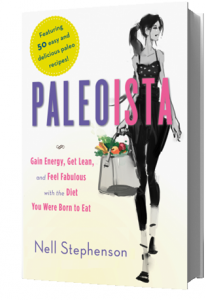Like many diets, the Paleo or “caveman” way of eating requires a big change in eating habits, a lot of dedication, and more effort than the typical American’s diet takes. The paleo diet also calls for a major shift in how one thinks about traditional nutrition. The book Paleoista: Gain Energy, Get Lean, and Feel Fabulous with the Diet You Were Born To Eat claims all of this and more.
The paleo diet, which first gained popularity in the 70s, has a lot of good things going for it. Dieters are instructed to cut out refined sugars and processed foods and eat more fruits and vegetables. Then comes the interesting part – all grains and dairy products are strictly forbidden. No beans, soy, tofu, quinoa, or goat cheese, what many people commonly think of as healthy foods. It’s similar to eating a vegan diet in the sense of eating lots of raw, natural foods, but paleos add lean meat, and lots of it.
Paleoista is different from the profusion of other paleo diet books in that it focuses on women. A diet whose nickname is “caveman” hardly sounds appealing to many individuals but the author, Nell Stephenson, wants her female readers especially to know that this diet can be followed by stylish, modern women (and men) who successfully balance their careers and families and still have energy left over at the end of the day.
The book is divided into three parts: part one explains the paleo lifestyle and its basic philosophy; part two gives practical applications of it; and part three contains recipes. Stephenson explains the diet in an easy, conversational manner and peppers in stories from others who have made the switch back to how, supposedly, their ancestors may have eaten. The recipes section is abundant and creative, with titles such as “Sautéed Shrimp in Meyer Lemon-Ginger Sauce with Bok Choy” and “Frozen Coconut-Espresso Blended Beverage.” But the recipe for “Roasted Bone Marrow on Arugula” made me cringe a bit (OK, I’ll be honest – a lot!).
Maybe I’m just too attached to breads and pastas, but I find a few things to criticize about this diet. First, how do we pinpoint what time in history was the perfect diet for humans? So many cultures and civilizations eat differently and conclusive evidence that one reigns supreme is hard to claim. Many experts call this a fad diet, which would be easy to say about many eating plans. And as a side note, to claim that prehistoric man ate like this is a little ridiculous – for example, this diet incorporates many coconut products, espresso, a tropical fruit, and also chickens and their eggs, a domesticated animal.
The book gives several accounts of individuals whose health problems declined or disappeared after making the switch to paleo. This is one of the diet’s strong points, as well as the fact that it has helped people lose lots of weight quickly. But most diets that cut out junk food and sugar would do the same thing; and most nutrition experts would agree that any diet that has you cutting out entire groups of food, like dairy or grain, should raise a flag. Paleo is, however, a good option for those with gluten allergies or an intolerance for dairy.
Paleoista would be a good read for any person who’s gone paleo or someone considering it who wants reassurance that plenty of “normal,” non-Ironman athletes can do this diet and still find a lot of tasty food on it (minus the bone marrow!).
Also Read:
Cookbook Review: Make it Paleo: Over 200 Grain-Free Recipes for Any Occasion
The Paleo Diet Enters the Medical Field with Paleo Physicians Network
